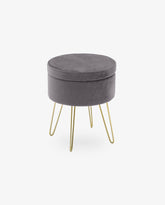Are Wicker, Rattan or Cane the Same? What's the Difference?
It's no secret that the wicker, rattan and cane furniture has been blowing up in the last few years. Your Instagram and Pinterest feeds must be flooded with those natural, woven chairs or home decors like baskets and lamps. But have you ever stopped and wondered: "What is wicker? What is rattan? What is cane? And how are they different?"
Since these three terms are often interchanged in the home decor realm, you could be forgiven for thinking wicker, rattan and cane are one and the same. But they're not! In this post, we'll share with you everything we've discovered to clear up all of the confusion around these terms "wicker vs rattan vs cane", and help you get updated about their pros and cons. Read on to find out more about:
CONTENTS

Over time, the confusion arises because "wicker" is such a catch-all term that has come to encompass many types of woven furniture. So you get it now - wicker refers to a weaving process, rather than a specific material. And if you're not pretty sure what your woven furniture is made from, wicker is probably the safest word to use.
Once the rattan plant is processed, it gets split into two parts: the core reed (rattan) and the outer skin or bark (cane). Because of this, pieces that feature thin, woven accents, like the back of a dining chair or on a cabinet door, are frequently considered cane. And items with larger, reed-like features are normally rattan. That is to say, rattan is used in the main weaving of wicker furniture, such as a papasan or outdoor lounge chair, while cane is generally used to attach the items together and in the finishing details.
You will often find brightly colored, treated and painted rattan but plain cane, due to the excellent water repellency of cane. Rattan is porous and easily damaged by moisture. So be sure to cover the natural rattan furniture outside when it rains.

Lightweight: Wicker, rattan and cane chairs are much lighter than solid wood and metal furniture. Easy to be moved around, wicker furniture is great for both indoor and outdoor use.
Durable: When properly cared, cane and treated rattan furniture can last up to three decades. You can wipe it down with a dry towel, since the cane repels liquid or moisture.
Eco-Friendly: Rattan is the second-fastest-growing material (after willow), regenerating within 5 to 7 years. A highly renewable material for furniture production!

Less Comfortable: Unlike cushy accent chairs or plushy couches, rattan cane furniture is usually hard and less comfortable. So it's better to upholster your modern cane chair for upgraded comfort.
Loosens Over Time: Unfortunately, the weaving of rattan cane furniture can loosen as time goes by. Replace it with a new one or send it to a professional for help.
In addition to dusting your wick rattan cane chairs regularly, it's highly recommended to keep your them out of rain and direct sunlight outdoors. Having your cane chairs sitting in the rain will eventually lead to mildew, while the exposure to sizzling sunlight will gradually cause them to discolor and crack. Save your cane chairs for indoors, and use resin or synthetic wicker chairs for outdoors. Believe us! Treat them right from the beginning, and you should be able to pass them down to your future generations!
Since these three terms are often interchanged in the home decor realm, you could be forgiven for thinking wicker, rattan and cane are one and the same. But they're not! In this post, we'll share with you everything we've discovered to clear up all of the confusion around these terms "wicker vs rattan vs cane", and help you get updated about their pros and cons. Read on to find out more about:
CONTENTS
- What is Wicker, Rattan or Cane? What's Their Differences?
- Pros and Cons of Rattan Cane Furniture
- How to Clean and Care Rattan Cane Furniture
- Rattan Cane Chairs Recommendations
What is Wicker, Rattan or Cane? What's Their Differences?
- Wicker vs Rattan and Cane

Rattan Palm Tree
Over time, the confusion arises because "wicker" is such a catch-all term that has come to encompass many types of woven furniture. So you get it now - wicker refers to a weaving process, rather than a specific material. And if you're not pretty sure what your woven furniture is made from, wicker is probably the safest word to use.
- The History of Wicker
- Rattan vs Cane
Once the rattan plant is processed, it gets split into two parts: the core reed (rattan) and the outer skin or bark (cane). Because of this, pieces that feature thin, woven accents, like the back of a dining chair or on a cabinet door, are frequently considered cane. And items with larger, reed-like features are normally rattan. That is to say, rattan is used in the main weaving of wicker furniture, such as a papasan or outdoor lounge chair, while cane is generally used to attach the items together and in the finishing details.
You will often find brightly colored, treated and painted rattan but plain cane, due to the excellent water repellency of cane. Rattan is porous and easily damaged by moisture. So be sure to cover the natural rattan furniture outside when it rains.

Rattan & Cane and Their Uses
Pros and Cons of Rattan Cane Furniture
- The Benefits of Using Wicker, Rattan and Cane
Lightweight: Wicker, rattan and cane chairs are much lighter than solid wood and metal furniture. Easy to be moved around, wicker furniture is great for both indoor and outdoor use.
Durable: When properly cared, cane and treated rattan furniture can last up to three decades. You can wipe it down with a dry towel, since the cane repels liquid or moisture.
Eco-Friendly: Rattan is the second-fastest-growing material (after willow), regenerating within 5 to 7 years. A highly renewable material for furniture production!

Disadvantages of Rattan and Cane Furniture
Pricey: As rattan cane furniture surged in popularity and processing the raw materials does not come cheap, the price tag for wicker furniture is usually high.Less Comfortable: Unlike cushy accent chairs or plushy couches, rattan cane furniture is usually hard and less comfortable. So it's better to upholster your modern cane chair for upgraded comfort.
Loosens Over Time: Unfortunately, the weaving of rattan cane furniture can loosen as time goes by. Replace it with a new one or send it to a professional for help.
How to Clean and Care Rattan Cane Furniture
How long does rattan furniture last? You might ask. It depends on how much you care about it. Now that you've known the difference between wicker, rattan and cane, and their pros and cons, it's time to learn how to care for them. A damp cloth or towel is enough to wipe dust and grime off, making your rattan cane furniture look good. And for deeper cleaning, try a wood soap or a mild detergent in warm water, and even use a super soft-bristled paintbrush to get into any nooks and crannies.In addition to dusting your wick rattan cane chairs regularly, it's highly recommended to keep your them out of rain and direct sunlight outdoors. Having your cane chairs sitting in the rain will eventually lead to mildew, while the exposure to sizzling sunlight will gradually cause them to discolor and crack. Save your cane chairs for indoors, and use resin or synthetic wicker chairs for outdoors. Believe us! Treat them right from the beginning, and you should be able to pass them down to your future generations!









